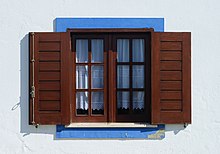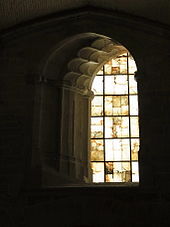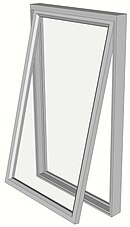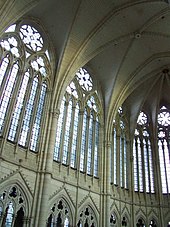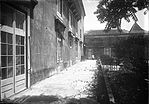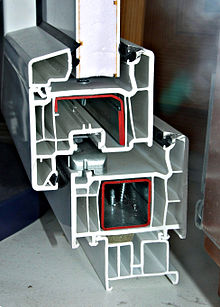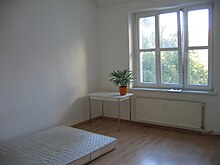From Wikipedia, the free encyclopedia
This article is about the part of a building. For the graphical user interface element, see Window (computing). For the Microsoft's computer operating system, see Windows. For other uses, see Window (disambiguation) and Windows (disambiguation).
Window of traditional design in Porto Covo, Portugal
Modern windows are usually glazed or covered in some other transparent or translucent material. Windows are held in place by frames.[2] Many glazed windows may be opened, to allow ventilation, or closed, to exclude inclement weather.[3] Windows often have a latch or similar mechanism to lock the window shut.
Types include the eyebrow window, fixed windows, single-hung and double-hung sash windows, horizontal sliding sash windows, casement windows, awning windows, hopper windows, tilt and slide windows (often door-sized), tilt and turn windows, transom windows, sidelight windows, jalousie or louvered windows, clerestory windows, skylights, roof windows, roof lanterns, bay windows, oriel windows, thermal, or Diocletian, windows, picture windows, emergency exit windows, stained glass windows, French windows, and double- and triple paned windows.
The Romans were the first known to use glass for windows, a technology likely first produced in Roman Egypt, in Alexandria ca. 100 AD. Paper windows were economical and widely used in ancient China, Korea and Japan. In England, glass became common in the windows of ordinary homes only in the early 17th century whereas windows made up of panes of flattened animal horn were used as early as the 14th century. In the 19th century American west, greased paper windows came to be used by itinerant groups. Modern-style floor-to-ceiling windows became possible only after the industrial plate glass making processes were perfected.
Contents
- 1 Etymology
- 2 History
- 3 Types
- 3.1 Eyebrow
- 3.2 Fixed
- 3.3 Single-hung sash
- 3.4 Double-hung sash
- 3.5 Horizontal sliding sash
- 3.6 Casement
- 3.7 Pivot
- 3.8 Tilt and slide
- 3.9 Transom
- 3.10 Side light
- 3.11 Jalousie window
- 3.12 Clerestory
- 3.13 Skylight
- 3.14 Roof
- 3.15 Roof lantern
- 3.16 Bay
- 3.17 Thermal
- 3.18 Picture
- 3.19 Multi-lite
- 3.20 Emergency exit/egress
- 3.21 Stained glass
- 3.22 French
- 3.23 Double-paned
- 3.24 Hexagonal window
- 4 Terms
- 5 Construction
- 6 Windows and the sun
- 7 Gallery
- 8 See also
- 9 References
- 10 External links
Etymology
The English language-word window originates from the Old Norse 'vindauga', from 'vindr – wind' and 'auga – eye', i.e., wind eye.[4] In Norwegian Nynorsk and Icelandic the Old Norse form has survived to this day (in Icelandic only as a less used synonym to gluggi), in Swedish the word vindöga remains as a term for a hole through the roof of a hut, and in the Danish language 'vindue' and Norwegian Bokmål 'vindu', the direct link to 'eye' is lost, just like for 'window'. The Danish (but not the Bokmål) word is pronounced fairly similarly to window.Window is first recorded in the early 13th century, and originally referred to an unglazed hole in a roof. Window replaced the Old English eagþyrl, which literally means 'eye-hole,' and 'eagduru' 'eye-door'. Many Germanic languages however adopted the Latin word 'fenestra' to describe a window with glass, such as standard Swedish 'fönster', or German 'Fenster'. The use of window in English is probably because of the Scandinavian influence on the English language by means of loanwords during the Viking Age. In English the word fenester was used as a parallel until the mid-18th century. Fenestration is still used to describe the arrangement of windows within a façade, as well as defenestration, meaning to throw something out of a window.
History
Fragment of a Roman window glass plate dated to 1st to 4th century A.D.
Note the obvious curvature, this is not a flat pane.
Note the obvious curvature, this is not a flat pane.
Alabaster window in the Valencia Cathedral. Note the asymmetrical, slanted left side of the wall-frame, which lets sun rays reach the chancel.
Over the centuries techniques were developed to shear through one side of a blown glass cylinder and produce thinner rectangular window panes from the same amount of glass material. This gave rise to tall narrow windows, usually separated by a vertical support called a mullion. Mullioned glass windows were the windows of choice among European well-to-do, whereas paper windows were economical and widely used in ancient China, Korea and Japan. In England, glass became common in the windows of ordinary homes only in the early 17th century whereas windows made up of panes of flattened animal horn were used as early as the 14th century.[5]
Modern-style floor-to-ceiling windows became possible only after the industrial plate glass making processes were perfected. Modern windows are usually filled with glass, although a few are transparent plastic.[2]
Types
Eyebrow
The term eyebrow window is used in two ways: a curved top window in a wall or in an eyebrow dormer; and a row of small windows usually under the front eaves such as the James-Lorah House in Pennsylvania.[6]Fixed
A window that cannot be opened, whose function is limited to allowing light to enter (unlike an unfixed window, which can open and close). Clerestory windows are often fixed. Transom windows may be fixed or operable. This type of window is used in situations where light or vision alone is needed as no ventilation is possible windows without the use of trickle vents or overglass vents.Single-hung sash
One sash is movable (usually the bottom one) and the other fixed. This is the earlier form of sliding sash window, and is also cheaper.[2]Double-hung sash
A sash window is the traditional style of window in the United Kingdom, and many other places that were formerly colonized by the UK, with two parts (sashes) that overlap slightly and slide up and down inside the frame. The two parts are not necessarily the same size; where the upper sash is smaller (shorter) it is termed a cottage window. Currently most new double-hung sash windows use spring balances to support the sashes, but traditionally, counterweights held in boxes on either side of the window were used. These were and are attached to the sashes using pulleys of either braided cord or, later, purpose-made chain. Three types of spring balances are called a tape or clock spring balance; channel or block-and-tackle balance; and a spiral or tube balance.Double-hung sash windows were traditionally often fitted with shutters. Sash windows can be fitted with simplex hinges that let the window be locked into hinges on one side, while the rope on the other side is detached—so the window can be opened for fire escape or cleaning.
Horizontal sliding sash
Has two or more sashes that overlap slightly but slide horizontally within the frame. In the UK, these are sometimes called Yorkshire sash windows, presumably because of their traditional use in that county.Casement
Main article: Casement window
A window with a hinged sash that swings in or out like a door
comprising either a side-hung, top-hung (also called "awning window";
see below), or occasionally bottom-hung sash or a combination of these
types, sometimes with fixed panels on one or more sides of the sash.[1] In the USA, these are usually opened using a crank, but in parts of Europe they tend to use projection friction stays and espagnolette locking. Formerly, plain hinges were used with a casement stay. Handing
applies to casement windows to determine direction of swing; a casement
window may be left-handed, right-handed, or double. The casement window
is the dominant type now found in modern buildings in the UK and many
other parts of Europe.Awning
Awning window
Hopper
A hopper window is a bottom-pivoting casement window that opens by tilting vertically, typically to the inside.[8] (Mostly used for schools)Pivot
A window hung on one hinge on each of two opposite sides which allows the window to revolve when opened. The hinges may be mounted top and bottom (Vertically Pivoted) or at each jamb (Horizontally Pivoted). The window will usually open initially to a restricted position for ventilation and, once released, fully reverse and lock again for safe cleaning from inside. Modern pivot hinges incorporate a friction device to hold the window open against its own weight and may have restriction and reversed locking built in. In the UK, where this type of window is most common, they were extensively installed in high-rise social housing.Tilt and slide
A window (more usually a door-sized window) where the sash tilts inwards at the top and then slides horizontally behind the fixed pane.Tilt and turn
A tilt and turn window can both tilt inwards at the top or open inwards from hinges at the side. This is the most common type of window in Germany, its country of origin. It is also widespread in many other European countries. In Europe it is usual for these to be of the "turn first" type. i.e. when the handle is turned to 90 degrees the window opens in the side hung mode. With the handle turned to 180 degrees the window opens in bottom hung mode. Most usually in the UK the windows will be "tilt first" i.e. bottom hung at 90 degrees for ventilation and side hung at 180 degrees for cleaning the outer face of the glass from inside the building.[9]Transom
A window above a door; in an exterior door the transom window is often fixed, in an interior door it can open either by hinges at top or bottom, or rotate on hinges. It provided ventilation before forced air heating and cooling. A fan-shaped transom is known as a fanlight, especially in the British Isles.Side light
Windows beside a door or window are called side-, wing-, and margen-lights and flanking windows.[10]Jalousie window
Jalousie or louvered window
Clerestory window
Clerestory
Main article: Clerestory
A window set in a roof structure or high in a wall, used for daylighting.Skylight
Main article: Daylighting
Roof
Hexagonal external cladding panels of roof in Eden Project Biomes (Cornwall, England,)
Roof lantern
Main article: Cupola
A roof lantern is a multi-paned glass structure, resembling a small
building, built on a roof for day or moon light. Sometimes includes an
additional clerestory. May also be called a cupola.Bay
Main article: Bay window
A multi-panel window, with at least three panels set at different angles to create a protrusion from the wall line.[1]Oriel
Main article: Oriel window
This form of bay window most often appears in Tudor-style houses and
monasteries. It projects from the wall and does not extend to the
ground. Originally a form of porch, they are often supported by brackets
or corbels.Thermal
Main article: Diocletian window
Thermal, or Diocletian, windows are large semicircular windows (or
niches) which are usually divided into three lights (window
compartments) by two mullions. The central compartment is often wider
than the two side lights on either side of it.Picture
A picture window is a large fixed window in a wall, typically without glazing bars, or glazed with only perfunctory glazing bars near the edge of the window. Picture windows provide an unimpeded view, as if framing a picture.[11]Multi-lite
A window glazed with small panes of glass separated by wooden or lead glazing bars, or muntins, arranged in a decorative glazing pattern often dictated by the building's architectural style. Due to the historic unavailability of large panes of glass, the multi-lit (or lattice window) was the most common window style until the beginning of the 20th century, and is still used in traditional architecture.Emergency exit/egress
A window big enough and low enough so that occupants can escape through the opening in an emergency, such as a fire. In many countries, exact specifications for emergency windows in bedrooms are given in many building codes. Specifications for such windows may also allow for the entrance of emergency rescuers. Vehicles, such as buses and aircraft, frequently have emergency exit windows as well.[12]Stained glass
Visual effect Sunlight shining through stained glass
Main article: stained glass
A window composed of pieces of colored glass, transparent, translucent or opaque,
frequently portraying persons or scenes. Typically the glass in these
windows is separated by lead glazing bars. Stained glass windows were
popular in Victorian houses and some Wrightian houses, and are especially common in churches.[13]French
Double-paned
Double-paned windows have two parallel panes (slabs of glass) with a separation of typically about 1 cm; this space is permanently sealed and filled at the time of manufacture with dry air or other dry nonreactive gas. Such windows provide a marked improvement in thermal insulation (and usually in acoustic insulation as well) and are resistant to fogging and frosting caused by temperature differential. They are widely used for residential and commercial construction in intemperate climates. Triple-paned windows have been commercially manufactured and marketed with claims of additional benefit but have not become common. In the UK double-paned and triple-paned are referred to as double-glazing and triple-glazing.Hexagonal window
Main article: hexagonal window
A hexagonal window is a hexagon-shaped window, resembling a bee cell
or crystal lattice of graphite. The window can be vertically or
horizontally oriented, openable or dead. It can also be regular or
elongately-shaped and can have a separator (mullion).
Typically, the cellular window is used for an attic or as a decorative
feature, but it can also be a major architectural element to provide the
natural lighting inside buildings.Terms
EN 12519 is the European norm that describes windows terms officially used in EU Member States. The main terms are:
Casement window, with latticed lights
- Light, or Lite, is the area between the outer parts of a window (transom, sill and jambs), usually filled with a glass pane. Multiple panes are divided by mullions when load-bearing, muntins when not.[15]
- Lattice light is a compound window pane madeup of small pieces of glass held together in a lattice.
- Fixed window is a unit of one non-moving lite. The terms single-light, double-light, etc., refer to the number of these glass panes in a window.
- Sash unit is a window consisting of at least one sliding glass component, typically composed of two lites (known as a double-light).
- Replacement window in the United States means a framed window designed to slip inside the original window frame from the inside after the old sashes are removed. In Europe it usually means a complete window including a replacement outer frame.
- New construction window, in the US, means a window with a nailing fin that is inserted into a rough opening from the outside before applying siding and inside trim. A nailing fin is a projection on the outer frame of the window in the same plane as the glazing, which overlaps the prepared opening, and can thus be 'nailed' into place.
- In the UK and mainland Europe, windows in new-build houses are usually fixed with long screws into expanding plastic plugs in the brickwork. A gap of up to 13 mm is left around all four sides, and filled with expanding polyurethane foam. This makes the window fixing weatherproof but allows for expansion due to heat.
- Lintel is a beam over the top of a window, also known as a transom.
- Window sill is the bottom piece in a window frame. Window sills slant outward to drain water away from the inside of the building.
- Secondary glazing is an additional frame applied to the inside of an existing frame, usually used on protected or listed buildings to achieve higher levels of thermal and sound insulation without compromising the look of the building
- Decorative millwork is the moulding, cornices and lintels often decorating the surrounding edges of the window.
Labeling
The United States NFRC Window Label lists the following terms:- Thermal transmittance (U-factor), best values are around U-0.15 (equal to 0.8 W/m2/K)
- Solar heat gain coefficient (SHGC), ratio of solar heat (infrared) passing through the glass to incident solar heat
- Visible transmittance (VT), ratio of transmitted visible light divided by incident visible light
- Air leakage (AL), measured in cubic foot per minute per linear foot of crack between sash and frame
- Condensation resistance (CR), measured between 1 and 100 (the higher the number, the higher the resistance of the formation of condensation)[16]
Construction
5-chamber plastic window profile
Examples of modern plastic and wooden window profiles with insulated glazing
Grids or muntins
These are the pieces of framing that separate a larger window into smaller panes. In older windows, large panes of glass were quite expensive, so muntins let smaller panes fill a larger space. In modern windows, light-colored muntins still provide a useful function by reflecting some of the light going through the window, making the window itself a source of diffuse light (instead of just the surfaces and objects illuminated within the room). By increasing the indirect illumination of surfaces near the window, muntins tend to brighten the area immediately around a window and reduce the contrast of shadows within the room.Frame and sash construction
Frames and sashes can be made of the following materials:| Material | Thermal resistance | Durability | Maintenance | Cost | Recycled content | Comment |
|---|---|---|---|---|---|---|
| Wood | very good | variable | high | high | low | shrinks and swells with humidity changes |
| uPVC ("vinyl") | very good | very good* | very low | average | very low | has a life span of 50 years in average |
| Aluminum | very good** | good | very low | low | typically > 95% | mostly thermally broken by a thermal insulation profile |
| Wood-Aluminium | very good | good | very low | high | high | used in modern buildings |
| Steel | medium | superior | very low | high | > 98% | typically welded at corner joints |
| Fiberglass | very good | very good* | very low | high | medium |
** Modern aluminium window frames are typically separated by a thermal break made of a glass fibre reinforced polyamide. With a 34mm thermal insulation profile it is possible to reach Uf= 1.3 W/m²K for a metal window. This greatly increases thermal resistance, while retaining virtually all of the structural strength.
Composites (also known as Hybrid Windows) [19] may combine materials to obtain aesthetics of one material with the functional benefits of another.
A typical installation of insulated glazing windows with uPVC window frames.
Glazing and filling
Low-emissivity coated panes reduce heat transfer by radiation, which, depending on which surface is coated, helps prevent heat loss (in cold climates) or heat gains (in warm climates).High thermal resistance can be obtained by evacuating or filling the insulated glazing units with gases such as argon or krypton, which reduces conductive heat transfer due to their low thermal conductivity. Performance of such units depends on good window seals and meticulous frame construction to prevent entry of air and loss of efficiency.
Modern double-pane and triple-pane windows often include one or more low-e coatings to reduce the window's U-factor (its insulation value, specifically its rate of heat loss). In general, soft-coat low-e coatings tend to result in a lower solar heat gain coefficient (SHGC) than hard-coat low-e coatings.
Modern windows are usually glazed with one large sheet of glass per sash, while windows in the past were glazed with multiple panes separated by glazing bars, or muntins, due to the unavailability of large sheets of glass. Today, glazing bars tend to be decorative, separating windows into small panes of glass even though larger panes of glass are available, generally in a pattern dictated by the architectural style at use. Glazing bars are typically wooden, but occasionally lead glazing bars soldered in place are used for more intricate glazing patterns.
Other construction details
Many windows have movable window coverings such as blinds or curtains to keep out light, provide additional insulation, or ensure privacy. Windows allow natural light to enter, but too much can have negative effects such as glare and heat gain. Additionally, while windows let the user see outside, there must be a way to maintain privacy on in the inside.[22] Window coverings are practical accommodations for these issues.Windows and the sun
Main article: Daylighting
Sun incidence angle
Historically, windows are designed with surfaces parallel to vertical building walls. Such a design allows considerable solar light and heat penetration due to the most commonly occurring incidence of sun angles. In passive solar building design, an extended eave is typically used to control the amount of solar light and heat entering the window(s).An alternative method is to calculate an optimum window mounting angle that accounts for summer sun load minimization, with consideration of actual latitude of the building. This process has been implemented, for example, in the Dakin Building in Brisbane, California—in which most of the fenestration is designed to reflect summer heat load and help prevent summer interior over-illumination and glare, by canting windows to nearly a 45 degree angle.
Solar window
Main article: Photovoltaics
Photovoltaic windows not only provide a clear view and illuminate
rooms, but also convert sunlight to electricity for the building.[23] In most cases, translucent photovoltaic cells are used.Passive solar
Passive solar windows allow light and solar energy into a building while minimizing air leakage and heat loss. Properly positioning these windows in relation to sun, wind, and landscape—while properly shading them to limit excess heat gain in summer and shoulder seasons, and providing thermal mass to absorb energy during the day and release it when temperatures cool at night—increases comfort and energy efficiency. Properly designed in climates with adequate solar gain, these can even be a building's primary heating system.Window coverings
A window covering is a shade or screen that provides multiple functions. For example, some window coverings control solar heat gain and glare. There are external shading devices and internal shading devices.[24] Low-e window film is a low-cost alternative to window replacement to transform existing poorly-insulating windows into energy-efficient windows. For high-rise buildings, smart glass can provide an alternative.Gallery
-
Classical Chinese window in Lan Su Chinese Garden
-
Arab-style windows in Jerusalem
-
Romanesque/Gothic window from Abbey of St. Maria d'Arles
-
-
A half-glazed window of the 17th century from Scotland
-
Window, Villa Majorelle, France
-
Asymmetrical windows at a building in the backyard of an arts museum in Osnabrück, Germany
-
A Russian Revival-style window
See also
References
|url= value (help). The Free Dictionary By Farlex. Retrieved May 19, 2012.- Beckett, H. E., & Godfrey, J. A. (1974). Windows: Performance, design and installation. New York, NY: Van Nostrand Reinhold Company.
External links
| Look up window in Wiktionary, the free dictionary. |
| Wikimedia Commons has media related to Windows. |
